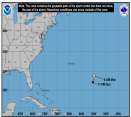Ed Dunham
Former Meteorologist & CFHC Forum Moderator (Ed Passed Away on May 14, 2017)
Reged:
Posts: 2565
Loc: Melbourne, FL
|
 Synoptic Synopsis
Synoptic Synopsis
Tue Aug 31 2010 11:15 AM
|
|
|
General Characteristics:
The tropical Atlantic seems to be performing as expected, but there are some anomalies. A high pressure ridge off the southeast coast of the United States has shoved uncommonly dry air southward into the central Bahamas. Dry air associated with the Saharan Air Layer (SAL) has been a semi-permanent feature in the tropical eastern Atlantic this season and tropical waves that exit the west African continent have been stifled by that feature. An abundance of early season upper level lows and their associated shear zones have finally tailed off and the Basin has become a little more favorable for tropical cyclone development.
Hurricane Earl:
Although currently maintained as a Category IV storm, Earl is wrapping up an Eyewall Replacement Cycle and the sustained winds probably dipped to about 105 knots during the cycle, or Category III – still a Major Hurricane. At 31/15Z, Earl was located about 205 miles east of Grand Turk Island, still moving to the west northwest at a slower forward speed of 10 knots. Tropical Storm Warnings are posted for the Turks & Caicos Islands and a Tropical Storm Watch is in effect for the southeastern Bahamas. Earl will soon have to contend with some mighty dry air to his northwest and I’d anticipate a gradual weakening of the hurricane as the storm pushes northwestward. Earl should pass about 250 to 300 miles (probably closer to 300 miles) east of east central Florida on Thursday morning, be located just off the Outer Banks of North Carolina early Thursday morning and offshore Cape Cod early Saturday morning with landfall in Nova Scotia early Saturday afternoon – IF he can survive the dry air and increasing windshear. High waves with some coastal flooding and dangerous rip currents from the Bahamas and Florida northward into the Canadian Maritimes as the hurricane passes close to shore. Just a slight track adjustment to the west could bring dangerous hurricane conditions onshore, so folks from eastern North Carolina to eastern Massachusetts should monitor Hurricane Earl for any forecast changes. Its possible that Tropical Storm Watches could be initiated for some of those locations later today or this evening.
Tropical Storm Fiona:
At 31/15Z, TS Fiona was located about 440 miles east of the Leeward Islands moving west to west northwest at 20 knots. Sustained winds are still at 35 knots and not much change is expected with dry air still limiting structural integrity. Fiona should eventually move northwest into a weakness in the Atlantic ridge that will have been enhanced by the northward progression of Hurricane Earl. Fiona should pass just to the northeast of the northern Leeward Islands and remain well offshore of the eastern CONUS. Tropical Storm Warnings and Watches are posted for various locations in the Leeward Islands and these notifications will change as Fiona gets closer to the Islands.
Invest 98L:
Located southwest of the Cape Verde Islands near 12N 30W at 31/12Z, Invest 98L was moving to the west northwest at 15 knots with sustained winds of 25 knots. On Monday night, dry air to the north fully exposed a very well developed circulation center. The system should continue moving to the west to west northwest for the remainder of the week, but additional development will be on the slow side until about Friday – due to the proximity of the SAL to its north. Development chances should improve toward the end of the week.
Africa:
At 31/12Z, two well-developed tropical waves over Africa were located at 15N 4W and 15N 10E. The waves are a bit too far to the north and they will eventually exit the west African coast right into the teeth of the SAL, i.e., development not very likely.
Except for a convective flare-up in the southwestern Gulf of Mexico, the remainder of the Gulf and the entire Caribbean Sea have no tropical activity.
ED
|
|





 Flat
Flat



